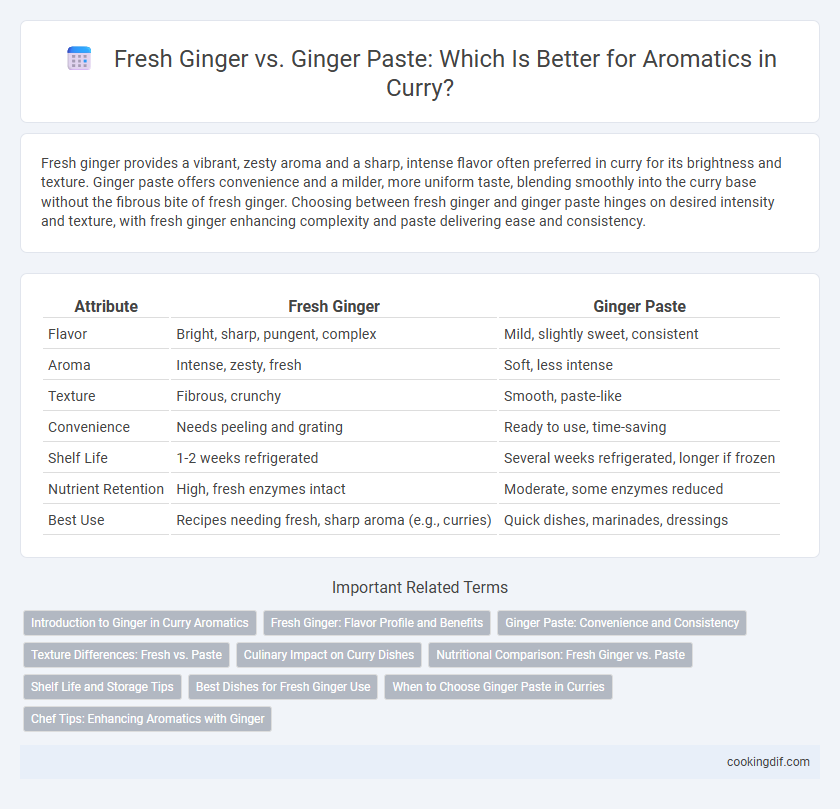Fresh ginger provides a vibrant, zesty aroma and a sharp, intense flavor often preferred in curry for its brightness and texture. Ginger paste offers convenience and a milder, more uniform taste, blending smoothly into the curry base without the fibrous bite of fresh ginger. Choosing between fresh ginger and ginger paste hinges on desired intensity and texture, with fresh ginger enhancing complexity and paste delivering ease and consistency.
Table of Comparison
| Attribute | Fresh Ginger | Ginger Paste |
|---|---|---|
| Flavor | Bright, sharp, pungent, complex | Mild, slightly sweet, consistent |
| Aroma | Intense, zesty, fresh | Soft, less intense |
| Texture | Fibrous, crunchy | Smooth, paste-like |
| Convenience | Needs peeling and grating | Ready to use, time-saving |
| Shelf Life | 1-2 weeks refrigerated | Several weeks refrigerated, longer if frozen |
| Nutrient Retention | High, fresh enzymes intact | Moderate, some enzymes reduced |
| Best Use | Recipes needing fresh, sharp aroma (e.g., curries) | Quick dishes, marinades, dressings |
Introduction to Ginger in Curry Aromatics
Fresh ginger delivers a vibrant, zesty flavor and crisp texture that elevates curry aromatics with natural oils and bright spiciness. Ginger paste offers convenience and consistent taste but may lack the freshness and complex nuances of freshly grated ginger. Using fresh ginger enhances the curry's aromatic profile by preserving its essential oils and sharp, pungent notes crucial for authentic flavor.
Fresh Ginger: Flavor Profile and Benefits
Fresh ginger boasts a vibrant, zesty flavor with bright citrusy notes and a pungent warmth that elevates curry dishes. Rich in gingerol, it delivers potent anti-inflammatory and digestive benefits, enhancing both taste and health. Using fresh ginger in curry ensures a more pronounced, authentic aroma and a crisp, lively texture that paste often lacks.
Ginger Paste: Convenience and Consistency
Ginger paste offers unparalleled convenience for curry preparations, eliminating the need for peeling and grating fresh ginger, which streamlines the cooking process and saves time. Its consistent texture and flavor ensure uniform aromatic intensity across dishes, enhancing the overall balance of spices. This ready-to-use form is ideal for busy kitchens seeking efficiency without compromising the essential zing that ginger brings to curry recipes.
Texture Differences: Fresh vs. Paste
Fresh ginger provides a fibrous, crunchy texture that releases vibrant citrusy and spicy notes when grated or finely chopped, enhancing the complexity of curry dishes. Ginger paste offers a smooth, uniform consistency that blends seamlessly into sauces, delivering a mellow and concentrated ginger flavor with minimal texture variation. Choosing between fresh and paste depends on the desired mouthfeel and intensity in the aromatic profile of the curry.
Culinary Impact on Curry Dishes
Fresh ginger delivers a vibrant, zesty flavor and a crisp texture that enhances the aromatic complexity of curry dishes, creating a bright and refreshing taste profile. Ginger paste offers convenience and a consistent, mellow heat but lacks the sharpness and freshness of freshly grated ginger, making it more suitable for long-simmered curries where depth of flavor is prioritized. Using fresh ginger in curry promotes a more dynamic and layered aromatic experience, while ginger paste provides ease and uniformity in flavor integration.
Nutritional Comparison: Fresh Ginger vs. Paste
Fresh ginger contains higher levels of gingerol, a bioactive compound with strong anti-inflammatory and antioxidant properties, than ginger paste, which may lose potency during processing. Fresh ginger also offers more vitamins and minerals, such as vitamin C, magnesium, and potassium, compared to paste that often contains added preservatives and sodium. Nutritionally, fresh ginger provides a more robust and natural profile, making it a preferable choice for enhancing the health benefits of curry dishes.
Shelf Life and Storage Tips
Fresh ginger offers a vibrant aroma and flavor but has a short shelf life of about three to four weeks when stored in the refrigerator in a paper towel and sealed bag. Ginger paste, often preserved with additives, extends shelf life to several months when kept in an airtight container in the fridge or freezer, making it a convenient option for long-term use. For optimal freshness, store fresh ginger in a cool, dry place or freeze thin slices, while ginger paste benefits from consistent refrigeration to maintain its potency and prevent spoilage.
Best Dishes for Fresh Ginger Use
Fresh ginger delivers a vibrant, zesty flavor ideal for curries like Thai green curry and Indian chicken tikka masala where aromatic intensity is crucial. Its fibrous texture and intense zing enhance dishes requiring long simmering, such as slow-cooked dals and fragrant biryanis. Fresh ginger's nuanced, bright notes are best showcased in recipes emphasizing fresh, bold flavors rather than relying on the convenience of ginger paste.
When to Choose Ginger Paste in Curries
Ginger paste offers convenience and a consistent flavor profile, making it ideal for quick curry preparations or when fresh ginger is unavailable. Its smoother texture blends seamlessly into sauces, enhancing the aromatic depth without the fibrous texture of fresh ginger. Choose ginger paste for dishes requiring uniform heat and subtle ginger undertones, especially in slow-cooked or simmered curries.
Chef Tips: Enhancing Aromatics with Ginger
Fresh ginger offers a vibrant, zesty aroma and crisp texture that elevates curry aromatics with natural oils and bright notes. Ginger paste provides convenience and consistent flavor but may lack the intensity and fresh pungency found in freshly grated ginger. Chefs recommend using fresh ginger when possible to maximize the depth and complexity of curry dishes, reserving ginger paste for quick preparation without sacrificing essential aromatic qualities.
Fresh ginger vs ginger paste for aromatics Infographic

 cookingdif.com
cookingdif.com